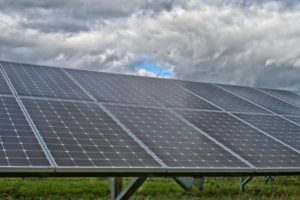Achieving Resilience Benefits Through Utility Solar + Storage Deployment & Community Solar Access in Low-Income Communities ARP Project Concludes
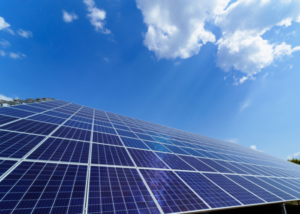 The NC Clean Energy Technology Center (NCCETC) recently concluded two projects focused on community solar access and achieving resilience benefits for low and moderate-income communities. The projects – Community Solar Access for Low and Moderate-Income Utility Customers, and Achieving Resilience Benefits Through Utility Solar + Storage Deployment in Low-Income Communities – were funded through the American Rescue Plan Act (ARPA).
The NC Clean Energy Technology Center (NCCETC) recently concluded two projects focused on community solar access and achieving resilience benefits for low and moderate-income communities. The projects – Community Solar Access for Low and Moderate-Income Utility Customers, and Achieving Resilience Benefits Through Utility Solar + Storage Deployment in Low-Income Communities – were funded through the American Rescue Plan Act (ARPA).
ARPA was passed in March 2021 to provide direct relief to Americans, contain the COVID-19 virus and rescue the economy. The North Carolina Department of Health and Human Services (NCDHHS) was a direct recipient and, according to their website, ARPA funds will be used to strengthen current health and human services-related programs and invest in new programs.
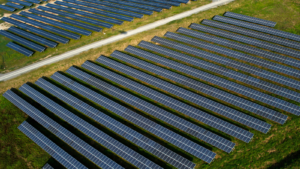
Vincent Potter, Policy Analyst at NCCETC and principal investigator for the two ARPA projects, discussed how the work focused on improving lower-income access to community solar energy within North Carolina by quantifying previously uncounted benefits including energy storage.
“Between March and September, 2022, the project team at NCCETC examined approaches to improve the economics of community solar projects and policy support for lower-income participation in community solar programs,” Potter said.
Community Solar and Storage in North Carolina
Previous work by the NCCETC has shown community solar to be a viable program model for participation in North Carolina’s solar economy. From 2017-2020, NCCETC led the Community Solar for the Southeast Project, part of the U.S. Department of Energy’s Solar Energy Evolution and Diffusion Studies – State Energy Strategies (SEEDSII-SES) funding program. The project team conducted technical assistance for nine cooperative and municipal utilities in the Southeastern US, evaluating the feasibility of community solar and energy storage facilities.
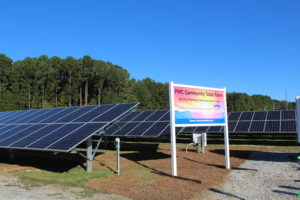
The successful deployment of the Fayetteville Public Works Commission (PWC) Community Solar Program shows that a community solar program coupled with energy storage could be a financially viable opportunity for similar utilities to consider.
Through the Community Solar Program, customers pay a monthly subscription fee, and in exchange, receive a bill credit for the value of the solar less the cost to operate. All Fayetteville electric customers – whether owning or renting and whether residential or non-residential – can participate as a ‘subscriber’ in the program.
Last year, NCCETC staff assisted with distributing funds from the federal CARES Act on behalf of the North Carolina Department of Environmental Quality to provide community solar subscriptions to lower-income utility customers at four North Carolina municipal and cooperative utilities.
The Fayetteville PWC received CARES Act Community Solar Access for Low and Moderate-Income Utility Customers funding in September 2021, enabling 26 eligible customers to participate in the Community Solar Program despite the program being fully subscribed otherwise.
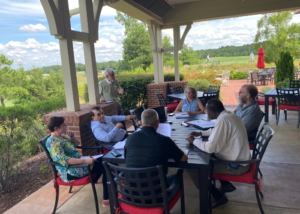
“Community solar programs can alleviate some of the obstacles for those who can’t afford or aren’t able to install solar on their own homes and businesses,” according to Potter, “But there’s still limited policy support and limited subscription availability across the Southeast.”
NCCETC held two workshops to engage cooperative and municipal electric utilities, developers, local and state government officials, and subject matter experts on the topics of community solar in North Carolina. The two topics of the workshops were Increasing Benefits from a Community Solar Project in North Carolina and Preparing Community Solar for the Future in North Carolina.
Expanding Access to Community Solar in the Southeast
Although community solar is a promising model for extending the benefits of solar economy to lower-income Americans, current community solar programs still face barriers to participation. In regions like the Southeast United States, smaller-scale community solar programs are operating without extensive policy support, and the marginal economic benefits of these programs mean that they are often of little appeal to lower-income potential participants.
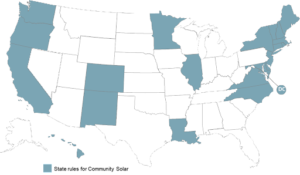 Potter stated, “As part of the ARPA project, we researched low and moderate-income customer targets, carve-outs, and funding mechanisms for community solar programs throughout the United States.” The Database of State Incentives for Renewables and Efficiency (DSIRE) lists 21 states with rules allowing or requiring utilities or other entities to develop community solar programs.
Potter stated, “As part of the ARPA project, we researched low and moderate-income customer targets, carve-outs, and funding mechanisms for community solar programs throughout the United States.” The Database of State Incentives for Renewables and Efficiency (DSIRE) lists 21 states with rules allowing or requiring utilities or other entities to develop community solar programs.
The Community Solar Access for Low and Moderate-Income Utility Customers project builds on previous work by taking direct action to support more community solar subscriptions. In the project’s second round, the funding aimed to broaden the spectrum of beneficiaries and foster development of self-sustaining subscription support programs by encouraging applicant utilities to use the funds received to complement replicable lower-income support programs developed by the utilities themselves and funded using non-government sources.
NCCETC partnered with three electric utilities in North Carolina to support 52 subscriptions of 10-years or more for a total $80,000. The partners – Piedmont Electric Cooperative, Randolph Electric Cooperative, and Roanoke Economic Development at the Roanoke Center (a subsidiary of Roanoke Electric Cooperative) – completed the subscription enrollments for their customers in September 2022.
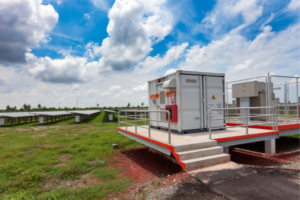
Another approach to overcome barriers to participation is to increase the benefits of community solar for participants by improving the underlying economics of the technology involved in the community solar program. “We found several approaches to increasing community solar benefits for lower-income participants,” Potter said. “Incorporating battery storage, recognition of additional value streams like resilience, repowering older solar arrays, designing larger-scale solar facilities, policy support, and opt-out program designs.”
In collaboration with Cliburn & Associates, NCCETC completed initial analysis for community solar and community plus storage for three NC municipal utilities to investigate the effects of battery storage to project and program economics.The addition of battery energy storage to a solar system can provide an additional value stream that could improve project economics.
NCCETC previously partnered with Cliburn & Associates on the Solar-Plus for Electric Cooperatives (SPECs) project, part of the National Renewable Energy Laboratory’s Solar Energy Innovation Network program. The project concluded in June 2021.
As part of this project, the team developed the Solar-Plus for Electric Cooperatives Early-Stage Decision Model, which allows for analysis of multiple value streams that can be garnered from solar-plus-storage projects including peak-shaving, ancillary services, distribution deferral, and resiliency value. Cliburn & Associates and NCCETC adapted and updated this model for use with community solar projects and is using the model to analyze possible community solar and energy storage projects for utilities in North Carolina.
 NCCETC also completed research into different subscription models and current and emerging best practices on community solar program design for low-income participants. For example, employing an opt-out community program may be one solution to overcome the information barriers to lower-income participants. Opt-out programs automatically enroll customers while providing the option to cancel subscription if desired.
NCCETC also completed research into different subscription models and current and emerging best practices on community solar program design for low-income participants. For example, employing an opt-out community program may be one solution to overcome the information barriers to lower-income participants. Opt-out programs automatically enroll customers while providing the option to cancel subscription if desired.
Carolina Solar Services, LLC has joined NCCETC to support analysis of the potential for repowering existing photovoltaic arrays with new modules for increased generation and new inverters for increased up-time, among other repowering strategies. The goal of this area of the project was to evaluate the potential to expand the capacity of existing community solar arrays interconnected to the distribution infrastructure of rural electric cooperatives in North Carolina.
Using engineering principles and best analysis, Carolina Solar Services constructed a model for expected output of the array under current conditions as well as under two scenarios: replacing the 315 watt seven-year-old panels with new panels of the same capacity, and replacing the panels with new panels of a larger capacity but the same dimensions to minimize site construction costs. Based on recommendations from a preliminary report from Carolina Solar Services, NCCETC studied the incorporation of battery storage, to understand the potential to replicate and scale a pilot initiative statewide.
Integrating Resiliency with Community Solar
Recently, investor-owned utilities in some regions of the United States have begun offering “Community Resiliency” programs wherein a commercial-scale customer (often a school, church or community center) hosts utility-owned solar-plus-storage system, which can provide economic and resilience benefits for the customer, the utility and the surrounding community.
Elizabeth Bowen, Senior Project Manager at NCCETC, supported the ARPA project seeking to create a scalable, cost-effective community resiliency program model for electric cooperatives to help address hurricane-related resilience needs. “We consulted with Roanoke Electric Cooperative to design and conduct feasibility studies for community resiliency service programs involving utility or third party-owned energy storage system deployment to support critical community centers,” said Bowen.
The initial solar and storage modeling results with opportunities for resiliency through community solar microgrids was presented in the second workshop hosted in September 2022. Based on data provided by Roanoke EC, the team identified and planned outage scenarios to meet power requirements and resilience needs at 100 percent and 75 percent loads.
“There’s still a lot of work to be done to create scalable solutions to expand community solar, but projects like these help set the stage for small electric utilities to explore their options for creating accessible programs for all customers,” Bowen said.
Stay tuned for an upcoming webinar featuring NCCETC’s developed models and tools for community solar best practices to increase benefits that can be shared between the utilities and customers to provide greater annual cost savings.
